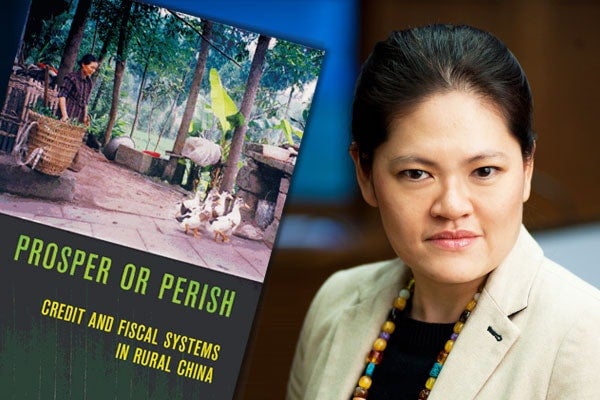
Indebted dragon: Lynette Ong explains China's construction economy
Published: January 8, 2013
The Chinese economy may be the envy of the world, but its impressive new development, from skyscrapers to highways, is underwritten by a risky strategy, warns Associate Professor Lynette Ong.
“Governments borrow money using land as collateral and repay the interest on their loans using funds they earn from selling or leasing the same land,” writes Ong in a recent lead article for Foreign Affairs magazine: Indebted Dragon: The Risky Strategy Behind China’s Construction Economy.
“All this means that the Chinese economy depends on a buoyant real estate market to keep grinding. If housing and land prices fall dramatically, a fiscal or banking crisis would likely soon follow. Meanwhile, local officials' hunger for land has displaced millions of farmers, leading to 120,000 land-related protests each year."
Jointly appointed by the Department of Political Science and the Munk School of Global Affairs (Asian Institute), Ong is a former An Wang Postdoctoral Fellow at the Fairbank Center for Chinese Studies, Harvard. Her research and teaching interests are in comparative political economy, the politics of development, politics of finance & public finance, fiscal federalism, climate change and environmental politics.
U of T News asked Ong to share a few details about her work, including her most recent book, "Prosper or Perish: The Political Economy of Credit and Fiscal Systems in Rural China" published by Cornell University Press.
Tell us a bit about your new book, Prosper or Perish: Credit and Fiscal Systems in Rural China
Prosper or Perish interweaves theoretically informed discussions of rural credit, development, governance and bank bailouts to identify various sources for China's uneven development. In the highly decentralized fiscal environment of the People's Republic, successful industrialization has significant implications for rural governance. Local governments depend on revenue from industrial output to provide public goods and services; unsuccessful enterprises starve local governments of revenue and result in radical cutbacks in services. High peasant burdens, land takings without adequate compensation by local governments and other poor governance practices tend to be associated with unsuccessful industrialization.
Prosper or Perish examines the bias in lending patterns of Rural Credit Cooperatives (RCCs), the official banking institutions for rural China, focusing on why the mobilization of rural savings has contributed to successful industrial development in some locales but not in others. Although these co-ops are mandated to support agricultural development among farm households, since 1980 half of RCC loans have gone to small and medium-sized industrial enterprises located in, and managed by, townships and villages. These township and village enterprises have experienced highly uneven levels of success, and by the end of the 1990s, half of all RCC loans were in or close to default, forcing China's central bank to bail out RCCs.
Institutional and informal mechanisms examined in the book have significant implications for understanding, in general terms, why financial resources are often deployed for political purposes, rather than for chasing highest economic returns. Inefficient construction projects described in the Foreign Affairs story is a prime example of the highly politicized financial sector in China.
The real estate bubble in China you described in Foreign Affairs sounds almost like a giant, land-based Ponzi scheme.
It is as much a Ponzi scheme as investors or savers seeking higher returns for their money in a financial market still highly controlled by the government. Depressed interest rates have made returns to bank savings negative after taking into account the rates of inflation. Additionally, given the lack of alternative savings instruments in China, people park their money in real estate, which promise extraordinarily high returns, at least until recently. In a nutshell, there is nothing illegal, unethical or irrational about throwing your money into projects that promise high returns.
What about China’s ghost cities, such as Ordos?
In these ghost cities, (Ordos in Inner Mongolia being the most infamous one, but by no means the only one in the country), you have nice posh new residential complexes, brand new office blocks, sometimes excellent infrastructure that allows the cities to function, the only thing is no one lives there. This is very much a supply—rather than demand-driven—story.
How many farmers have been displaced or adversely affected by all of this?
A conservative estimate suggests every mu of land (one-sixth of an acre) expropriated creates one displaced farmer. This suggests the number of displaced farmers increases by an annual rate of 250,000-300,000, putting the total being displaced between 1987 to 2010 to no fewer than 52 million.
What did you think of the recent Op Ed in the The New York Times by Henry Paulson Jr., How Cities Can Save China? He writes that “a flawed system of municipal finance is driving debt, corruption and dissent, while unsustainable urban planning has yielded polluted cities that are destroying China’s ecosystem” and predicts that China will have 200 cities with populations of more than one million by 2025.
Paulson has an informed but rather simplistic view of China’s urbanization. The real picture is more nuanced and complex than what is being described in the op-ed. China has a large number of “floating population” or migrant or transient workers who work in the cities but return to the countryside when the manufacturing and service economies in the cities go south. Consequently, the official urbanization rate may over-estimate the degree of urbanization.
What drew you to this field?
When I quit the corporate sector in Singapore a decade ago to return to graduate schools, there were three things that fascinated me but I knew nothing or very little about: finance, rural sector and China. Taking on a project that addressed the heart of these three things seemed like a natural thing to do. The rest is history.



